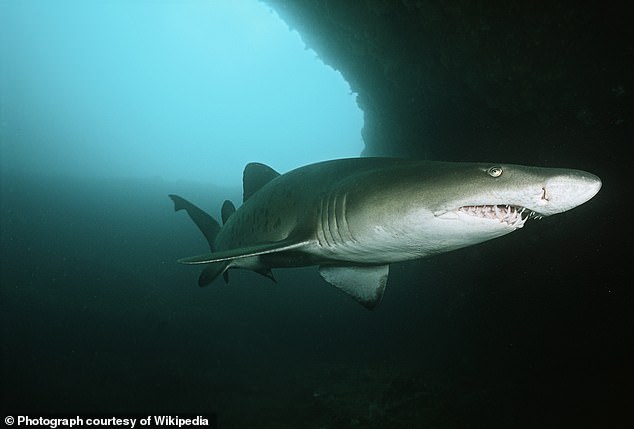New species of shark with ‘fangs’ discovered in Alabama that was the top predator 65 million years ago
Scientists have discovered a new species of shark that had “fangs” when it hunted in the waters off Alabama 65 million years ago.
The team has discovered 17 fossilized teeth that have been lying around for 100 years at a geological survey in Wilcox County who realized the remains looked nothing like anything ever recorded – living or extinct.
The shark, called Palaeohypotodus bizzocoi, could be about 10 feet long, similar to a sand tiger shark, and was thought to have been an important predator at the time when dinosaurs were wiped out from our planet.
Scientists have found 17 tooth fossils at the Geological Survey in Tuscaloosa, Alabama
Jun Ebersole, director of collections at the McWane Science Center, said he came across the collection of dental fossils a few years ago.
“It’s always exciting to discover a species that is new to science, but this one was particularly interesting because of the time period in which this shark lived,” Ebersole told Dailymail.com.
‘In this region we don’t know much about the marine life that lived during the Paleocene, so gaining additional insights into this time interval was particularly exciting.’
The team found the teeth collecting dust in a small box among a collection of other fossils.
After examination, researchers concluded that the remains belonged to the same ancient predator.
Ebersole and his team compared the teeth to other living sharks, including Great Whites and Makos, and found that they differed in shape depending on their placement in the tooth socket.
“By studying the jaws and teeth of living sharks, we were able to reconstruct the dentition of this ancient species and found that the tooth layout was different from that of any living shark,” said David Cicimurri, curator of natural history.

Scientists compared the tooth fossil to a Sandtiger shark, which is believed to be the closest species to the bozzocoi fossil
Of the 17 teeth collected, only nine were complete – the remaining eight tooth fossils consist of only the main cusp or are missing some or all of the roots.
Palaeohypotodus had small need-like canine teeth protruding from its jaws, which are found on living sharks that feast on bony fish, crustaceans and squid.
The extinct species was believed to have been the size and flattened, conical snout of a modern sand tiger shark, commonly found off the Carolinas, Georgia and Florida – all close to Alabama.
When Palaeohypotodus ruled the seas, the lower half of Alabama was covered by a shallow tropical to subtropical ocean.
The team said this is why the fossils were found so far inland; Wilcox County is located approximately 200 miles from the Gulf of Mexico.
“Shark discoveries like these give us tremendous insights into how ocean life recovers after major extinction events and also allow us to predict how global events, such as climate change, are affecting marine life today,” says T. Lynn Harrell, Jr., paleontologist and curator of fossil collections at the Geological Survey.
Ebersole said they were able to determine that the shark was from the Paleocene because of the geological layer it emerged from, which is just above the Cretaceous-Paleogene (K/Pg) boundary.
The border marks the period between the last period of the dinosaurs and the first period after the animals became extinct.
The new shark species was discovered in the layer just above the K/Pg boundary, showing that it lived during the Paleocene, about 65 million years ago.
Alabama is one of the best preserved areas in the world for the K/Pg boundary, where the period is visible in the rock layers.
